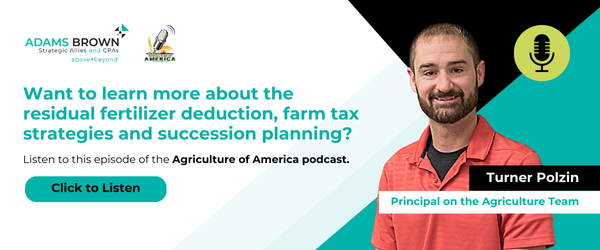Is your Entity Structure Right for your Farm?
A foundational strategy that impacts every aspect of the business from legal liability to tax obligations
Key Takeaways:
- As operations grow and employees incur liabilities, creating mechanisms that protect your assets and operations from each other is important.
- Choosing the right entity structure for a farm is a foundational strategy that impacts every aspect of the business from legal liability to tax obligations.
- As a farm evolves, so too might its needs for liability protection and tax management.
The business of farming is far from just tilling soil and planting seeds—it’s also about ensuring the sustainability and growth of your operation through smart financial structuring. As the agricultural landscape evolves with more complex market demands and regulatory requirements, choosing the right entity structure for your farm can significantly impact your financial protection, tax obligations and growth potential.
“It’s asset protection,” says Adams Brown agriculture team leader Bill Glazner. “As operations grow and employees incur liabilities, creating mechanisms that protect your assets and operations from each other is crucial. Imagine a trucking accident or an appendage in the auger. At the same time there are major government payments at play and the grain markets require risk protection.”
Key Considerations for Selecting an Entity Type
When it comes to deciding on an entity structure, farm owners should ask themselves:
- Is protection from legal liability a concern for the owner and/or partners?
- What is the makeup of the ownership group? If it includes other entities (i.e., partnerships), then the choice of entity types is limited.
- What are the tax implications of each entity type, given the needs and circumstances of the company owners?
- What are the owner’s needs regarding debt basis, which potentially enables owners to deduct losses?
Common Entity Structures in Farming
- Sole Proprietorship
This structure is straightforward—the business owner is the business, exposing them to any business liabilities. It offers no separation between personal and business assets, making it a risky choice for larger operations.
- Partnership
Often used in family and closely-held farm businesses, partnerships involve two or more individuals who share in the profits, losses and operational decisions. This structure allows profits or losses to pass through directly to partners at tax time, avoiding double taxation but not providing personal liability protection.
- Limited Liability Corporation
LLCs are popular among small to medium-sized farms. They combine the liability protection of a corporation with the tax benefits of a partnership. Owners can also choose to have the LLC taxed as an S corporation, though this requires all shareholders to be eligible and to consent in writing. The involvement level in the LLC can affect whether earnings are subject to self-employment taxes.
- S Corporation
An S corporation is a “pass-through” entity, meaning income, losses, deductions and credits pass through to shareholders for tax purposes, and it avoids corporate income tax at the federal level. This structure benefits shareholders by not subjecting their pass-through income to self-employment tax and allows for liability protection. However, profit distribution must be proportional to ownership stakes, limiting flexibility.
- C Corporation
Traditionally used by larger agricultural operations, C corporations offer the strongest liability protection. They allow for deductible expenses such as housing but suffer from double taxation—once at the corporate level and again on dividends to shareholders. Recent changes in tax law have diminished some benefits of C corporations, though they remain a viable option for farms needing substantial asset protection and organizational structure.
Special Considerations for C Corporations Electing S Corporation Status
A C Corporation electing S Corporation status must be mindful of the built-in gains tax over a five-year period. This tax applies if assets are sold at a gain that was present at the time of the S election. Additionally, all shareholders must qualify under S Corporation requirements.
The benefits of electing S Corporation status include eligibility for the Qualified Business Income deduction and favorable long-term capital gains tax rates on real estate and other investments, which are not available under traditional C Corporation treatment. Despite the switch in taxation, the legal structure remains intact, providing ongoing corporate protections.
Tax Reporting & Trust Considerations
C Corporations file taxes using Form 1120, whereas S Corporations and other pass-through entities use different forms that reflect individual income reporting. On the topic of succession planning, while a revocable trust offers flexibility akin to a will, an irrevocable trust serves a distinct purpose, providing a more permanent solution for asset protection and tax planning.
Changing Entity Structures
As a farm evolves, so too might its needs for liability protection and tax management. For instance, shifting from a sole proprietorship to an LLC can provide necessary asset protection as the business grows. Adjustments in the tax landscape or a change in the farm’s financial strategy might also prompt a shift, like moving from a C Corporation to an S Corporation to take advantage of more favorable tax treatments for pass-through income.
Conclusion
Choosing the right entity structure for a farm is more than a bureaucratic decision—it’s a foundational strategy that impacts every aspect of the business from legal liability to tax obligations. Consulting with farm tax accountants can provide personalized advice, ensuring your entity structure aligns with both current needs and future goals of the farm. Contact an Adams Brown farm CPA today.


